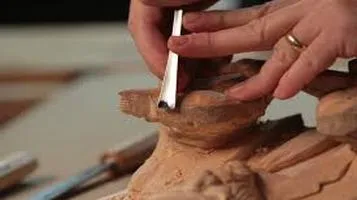Review about Woodworking and Carving
Woodworking and carving are traditional crafts that involve shaping and creating objects from wood. Woodworking encompasses a wide range of skills and techniques used to construct and design furniture, cabinetry, and various wooden structures. It involves processes such as cutting, shaping, and assembling wood using tools like saws, chisels, and planes. Carving, a more specialized aspect of woodworking, focuses on sculpting wood into intricate designs and figures. This art form requires precision and creativity, often resulting in decorative pieces like sculptures, ornaments, and reliefs. Both disciplines demand a keen eye for detail, patience, and a deep understanding of wood's natural characteristics. Woodworking and carving not only preserve age-old traditions but also offer a rewarding creative outlet.

History and Evolution
Woodworking and carving have a rich history, tracing back to ancient civilizations. Early humans utilized basic tools to shape wood into essential items such as weapons, utensils, and shelters. As societies evolved, so did the complexity and artistry of woodworking. The Egyptians, for instance, are renowned for their intricate wooden furniture, while the Chinese and Japanese have long traditions of exquisite woodwork and joinery.
During the Middle Ages, European woodworkers began to form guilds, standardizing techniques and elevating the craft to new heights. The Renaissance further propelled woodworking into the realm of fine art, with master carvers creating elaborate religious altarpieces and ornate furniture. This period also saw the development of specialized tools and the establishment of woodworking as a respected profession.
Techniques and Styles
Woodworking encompasses a broad range of techniques, each requiring a unique set of skills and tools. Broadly, it can be divided into two main categories: joinery and carving.
Joinery involves the assembly of wooden pieces using various techniques to create furniture and structural elements. Traditional joinery techniques like dovetail, mortise and tenon, and finger joints are celebrated for their strength and aesthetic appeal. Modern woodworking has also embraced new methods, including the use of adhesives and mechanical fasteners, but traditional joinery remains revered for its craftsmanship.
Carving, on the other hand, is the art of shaping wood by removing material to create decorative and functional objects. This can range from simple whittling to highly detailed relief carvings and sculptures. Techniques such as chip carving, relief carving, and sculpture carving each offer unique challenges and rewards. Mastery of carving requires not only technical precision but also a deep understanding of wood grain, texture, and the interplay of light and shadow.
Tools of the Trade
The tools used in woodworking and carving are as varied as the techniques themselves. Basic hand tools like saws, chisels, planes, and mallets are essential for any woodworker. These tools, often passed down through generations, hold a special place in the hearts of artisans, representing a tangible connection to the past.
Power tools, including routers, lathes, and sanders, have revolutionized woodworking by increasing efficiency and precision. While some purists prefer the tactile feedback and control of hand tools, others appreciate the versatility and time-saving benefits of power tools. In recent years, the advent of CNC (computer numerical control) machines has further expanded the possibilities of woodworking, allowing for intricate designs and mass production with remarkable accuracy.
Safety is paramount in woodworking, and proper use and maintenance of tools are crucial. Protective gear such as goggles, ear protection, and dust masks are essential to prevent injuries and long-term health issues.
The Resurgence of Woodworking
In an age dominated by digital technology and mass-produced goods, woodworking and carving have experienced a renaissance. This resurgence can be attributed to several factors. Firstly, there is a growing appreciation for handmade, artisanal products that stand in stark contrast to the homogeneity of factory-made items. Woodworking offers a tangible connection to tradition and craftsmanship, appealing to those who value authenticity and uniqueness.
Secondly, the rise of DIY (do-it-yourself) culture has inspired many to take up woodworking as a hobby. Online platforms like YouTube, Instagram, and Pinterest have democratized knowledge, making it easier than ever to learn new skills and share creations with a global audience. Woodworking communities, both online and offline, provide support, inspiration, and camaraderie for enthusiasts of all levels.
Moreover, the therapeutic benefits of woodworking cannot be overstated. In a fast-paced world, the act of working with one's hands offers a meditative escape, fostering mindfulness and reducing stress. The satisfaction of creating something tangible from raw materials is profoundly rewarding, instilling a sense of accomplishment and pride.
Conclusion
Woodworking and carving are more than just crafts; they are expressions of human ingenuity, creativity, and perseverance. From ancient toolmakers to modern artisans, the tradition of shaping wood has endured, adapting to new technologies while preserving its core principles. Whether as a hobby or a profession, woodworking offers endless opportunities for learning, growth, and artistic expression. The resurgence of interest in this timeless craft is a testament to its enduring appeal and the deep-seated human desire to create beauty and functionality from the simplest of materials.






